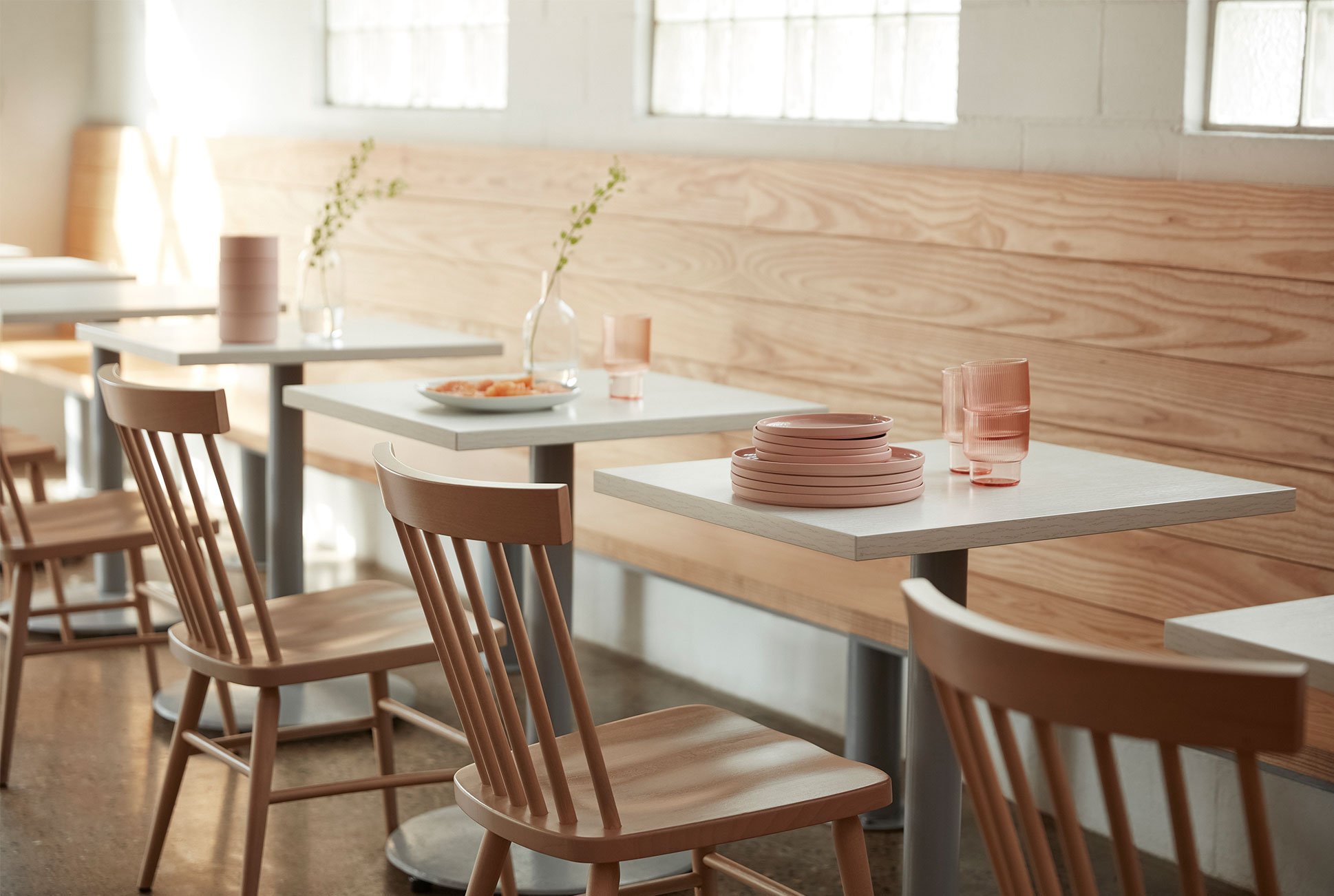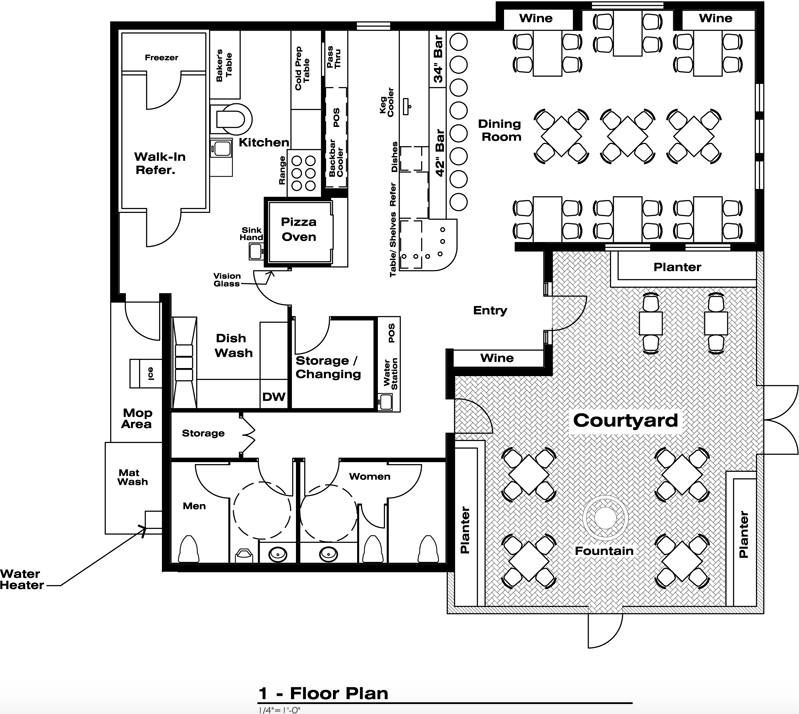There’s a strange phenomenon that occurs with restaurant layouts: when you’re eating somewhere with a great space, the furniture placement, decor, other patrons, and ambient noise of the kitchen all blend together into a comfortable environment where you can relax and enjoy a meal. But when it’s bad, you notice. With some careful attention to your restaurant furniture layout, it’s easy to avoid unpleasant situations for your customers. Here are some tips for creating a layout that works seamlessly:
- Let your desired atmosphere guide you
- Balance volume with comfort
- Keep functionality in mind
- Vary seating options for interest and optimizing space
- Don’t offer a bad seat
1. Decide Atmosphere
Your restaurant layout provides the base for the environment you want to create, so start by deciding what that is. Do you want your restaurant to be open and airy? Classic and familiar? Cozy and intimate? Each aesthetic has a different feel that will guide your furniture placement. You can achieve very different atmospheres by varying seat height, table size, booth quantities, bar seats, and tables. A snug layout may use more booths or banquettes with dividers to provide some privacy while giving the illusion of a closed off space, whereas a minimalist, breezy restaurant may want more high tables and bar seating.
 Sherman chairs in Sophomore Spanish Club
Sherman chairs in Sophomore Spanish Club
2. Balance Volume & Comfort
Creating a great restaurant furniture layout is a delicate balancing act: you want to maximize your revenue by seating as many customers as your kitchen can handle, but you can’t overcrowd your space. Having too many tables and chairs not only makes customers uncomfortable, it also impedes movement for wait staff, slowing down service and causing frustration for everyone. Too few seats is similarly annoying, as customers will have to wait for tables, causing you to lose money from fewer sales and an inefficient kitchen.
Instead, do plenty of planning when you're working on furniture type and placement. There's no such thing as going overboard, as this is a critical and often poorly executed step towards your perfect layout. Do some research on potential furniture pieces, measure out your space, and plan it out on paper. Then, round up some helpers and tape out your layout on the floor. Perform a mock service and pay close attention to spacing. Be sure you're confident in the preliminary layout before you move to ordering furniture.
3. Don't Forget About Function
In addition to quantity of seats, think carefully about the flow of your dining room. How do your customers get around? How about your staff? Where are the bottlenecks and where might space be wasted? Think about ways to incorporate clear paths through the dining room and to the restrooms for customer comfort, and intuitive lanes for servers and bussers to move from the kitchen to tables with ease. The design of your restaurant is as much about efficiency as it is aesthetics.
Don't forget about the ancillary spaces, too. For example, do you plan on doing a lot of takeout business? If you neglect to think about how picking up orders will work, you could end up with takeout customers clogging up waiting areas, hallways intended for kitchen traffic, or even taking seats at the bar without ordering anything, causing you to lose the revenue that an additional customer would bring. And speaking of waiting areas, what happens when you have a long queue? Without planning enough space for waiting, customers may be forced to stand awkwardly in the dining room or outside the restaurant, and may ultimately decide the wait isn’t worth it.
4. Vary Seating Options
As we mentioned earlier, certain seating options can create very different atmospheres in your restaurant, but beware: too much of the same can look dull and uninspired. If all of your seating is at stand-alone tables that are the same height, your dining space can look flat, monotonous, and crowded, and all booths feels awkward and probably doesn’t utilize the area to the fullest extent.
On the other hand, don’t get too caught up in the pursuit of variety. Depending on your space and the atmosphere you want to evoke in your restaurant, sticking to limited seating options can be a great way to drive home your aesthetic. For instance, a romantic date night restaurant might capitalize on a cozy space with small, two-seat tables, creating an environment that feels private and intimate. While it’s still a good idea to think about varying your seating options, it’s always important to consider different aspects of the restaurant that will lead to the best possible customer experience. Play with your restaurant furniture layout for a configuration that’s both visually engaging and functional.
.jpg?width=5700&name=6250BS_BradyBarstool_ZincYellow_Natural_BossRambler%20(3).jpg) Brady and Sherman barstools in Boss Rambler Beer Club
Brady and Sherman barstools in Boss Rambler Beer Club
5. No Bad Seats - Ever
At some point, you’ve probably been given the bad seat in a restaurant. You know the one: the drafty one right by the door, the loud one just outside the kitchen, or the awkward one to the left of the restrooms. These spaces exist in every restaurant space, and leaving them empty creates confusing design gaps and revenue loss. So, what do we mean when we say, “don’t offer a bad seat?” Make the most of it. Dividers, half-walls, planters, and curtains can all provide some cover and privacy from high-traffic areas and doors. Use decoration, artwork, light fixtures, and other interesting pieces to make traditionally “bad seats” into attractive options.
By putting in the time for thoughtful planning of your restaurant furniture layout, you can create a great looking dining room that facilitates easy, efficient service. When the furniture placement, aesthetic, and function of your restaurant space all work together, they create a flawless experience for your diners that sets your restaurant apart from others.

